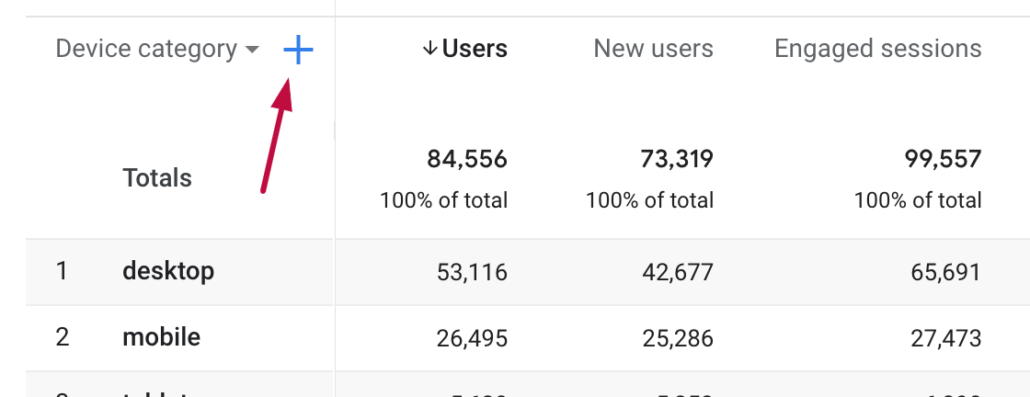Optimizing SEO with Secondary Dimension in Google Analytics
Optimizing SEO with Secondary Dimension in Google Analytics
Blog Article
Enhance Your Information Evaluation Making Use Of Second Measurement in Google Analytics
Discovering the abilities of additional dimensions in Google Analytics opens up a realm of opportunities for refining data evaluation. The ability to dissect details even more beyond the surface level provides a nuanced view that can shape calculated choices. By layering added dimensions onto primary information sets, a more complex story arises, clarifying customer communications and performance signs. This vibrant method to data evaluation holds the key to unlocking surprise patterns and patterns that can transform how organizations interpret their digital impact.
Understanding Second Measurements
Additional measurements in Google Analytics refer to additional specifications that can be included to the primary measurement, permitting for a more detailed analysis of information (Secondary Dimension in Google Analytics). By including second measurements, analysts can segment and filter information to reveal patterns, trends, and connections that may not be apparent when looking at the information as a whole.

Benefits of Making Use Of Additional Measurements
When assessing data in Google Analytics, the utilization of second measurements provides invaluable insights into customer actions and efficiency metrics. By including a second measurement to your main information, you can dig deeper into the characteristics of your website site visitors and their interactions. One of the vital advantages of utilizing additional dimensions is the ability to segment and contrast data better. This division permits you to understand how various variables, such as demographics or traffic resources, impact individual behavior and conversions (Secondary Dimension in Google Analytics).
Furthermore, second measurements help in determining patterns and relationships that might not be right away noticeable when taking a look at the data in seclusion. This deeper level of evaluation can uncover valuable information that can guide advertising approaches, internet site optimization, and overall company decisions. In addition, secondary measurements boost the context of your primary information, offering an extra thorough view of customer interaction and efficiency metrics. In general, using secondary dimensions in Google Analytics can dramatically improve the depth and quality of your data analysis, resulting in even more informed decision-making and boosted outcomes.
How to Add Second Dimensions
By incorporating second measurements in Google Analytics, individuals can acquire deeper understandings into their data evaluation procedure, allowing for even more extensive examination of customer habits and performance metrics. Including additional measurements is a simple procedure that can dramatically boost the deepness of analysis. As soon as in the report, locate the "Additional dimension" tab above the data table.
Studying Information With Secondary Dimensions
Using second measurements in data analysis provides a more thorough understanding of user habits and performance metrics. By adding a second measurement to your key data established in Google Analytics, you can delve much deeper into Resources the attributes of your web site visitors and their communications. For circumstances, integrating the primary measurement of 'source/medium' with the additional dimension of 'touchdown web page' can disclose which details pages are attracting traffic from various sources, aiding you optimize these web pages for far better involvement.

In essence, analyzing data with additional measurements empowers you to acquire beneficial insights into customer habits, recognize patterns, and make informed decisions to improve the performance of your digital properties.
Best Practices for Second Measurements
In information analysis, integrating second measurements properly can substantially enhance the deepness of insights originated from metrics and customer behavior patterns. When using additional measurements in Google Analytics or any various other logical device, it is vital to abide by best methods to ensure the precision and significance of the information analysis.
One secret best technique is to very carefully select additional dimensions that enhance the key measurement being assessed. Picking second dimensions that give added context or additional segmentation can offer a much more thorough understanding of the information. It is likewise important to stay clear of overcomplicating the analysis by consisting of as well many secondary measurements, which may result in confusion or dilution of understandings.
Moreover, it is recommended to explore various mixes of second and key measurements to reveal brand-new relationships and trends. Consistently fine-tuning the choice and evaluating of additional dimensions based upon the particular objectives of the evaluation can bring about even more workable insights. By adhering to these best methods, data analysts can take advantage of secondary measurements properly to improve the total information analysis procedure and decision-making capabilities.

Conclusion
Finally, incorporating secondary measurements in Google Analytics is necessary for a detailed information analysis technique. By leveraging secondary dimensions alongside main ones, online marketers and experts can discover important insights and connections that can inform decision-making and optimize digital advertising and marketing strategies. Comprehending how to properly use additional dimensions and complying with best practices will certainly permit experts to draw out significant data and enhance their overall performance metrics.
Second measurements in Google Analytics refer to additional parameters that can be included to the key dimension, permitting for a more their explanation comprehensive analysis of data. By incorporating secondary dimensions, analysts can sector and filter information you could try here to uncover patterns, patterns, and correlations that may not be obvious when looking at the data as a whole. Combining the primary measurement of 'source/medium' with the second measurement of 'landing web page' can reveal which details pages are drawing in traffic from various resources, assisting you enhance these pages for far better involvement.
One key best method is to thoroughly choose additional dimensions that match the main measurement being evaluated. By adhering to these finest techniques, information experts can take advantage of additional measurements efficiently to improve the total data analysis procedure and decision-making capacities.
Report this page